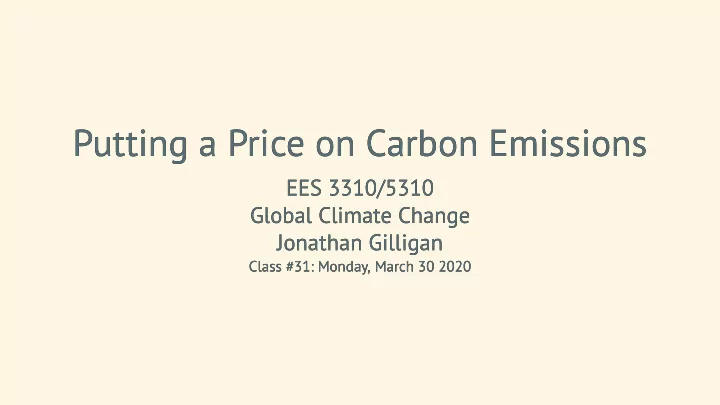

Putting a Price on Carbon Emissions Putting a Price on Carbon Emissions EES 3310/5310 EES 3310/5310 Global Climate Change Global Climate Change Jonathan Gilligan Jonathan Gilligan Class #31: Class #31: Monday, March 30 Monday, March 30 2020 2020 /
Review of Costs and Bene�ts Review of Costs and Bene�ts Total gross benefit = area under MB Total gross cost = area under MC Total net benefit = gross benefit − gross cost Light gray trapezoid /
Total Net Bene�t Total Net Bene�t /
Optimum Emissions Optimum Emissions Optimum emissions = E * EPA regulations allow E * emissions Total net benefits are maximized. /
Deadweight Losses Deadweight Losses Optimum emissions = E * EPA regulations allow E’ emissions Deadweight Loss (dark blue triangle) = difference between actual net benefit and optimum net benefit /
Deadweight Losses Deadweight Losses Optimum emissions = E * EPA regulations allow E’ emissions Deadweight Loss (dark blue triangle) = difference between actual net benefit and optimum net benefit /
Regulation Regulation /
Regulation Regulation Command and Control Market-Based Regulation Put a price on externalities Let the market decide best balance between costs and benefits of pollution Pigovian tax : Tax equal to social cost Directly compensate people hurt by pollution Or rebate other taxes: indirect compensation Or invest in socially beneficial projects Clean energy Infrastructure to adapt to climate change Compensate out-of-work coal miners /
Nordhaus on Pigovian Taxes Nordhaus on Pigovian Taxes Taxes on something makes people do less of it We want people to work, don’t want them to pollute But we tax working and don’t tax polluting Revenue-neutral carbon tax: Raise tax on CO 2 , cut payroll taxes /
Details Details People don’t like paying taxes Invisible taxes Charge tax when fossil fuels are extracted from ground or imported Fossil fuel producer pays tax, passes cost on to consumers Taxes → higher prices → less consumption Higher fuel prices: Incentive to buy energy-efficient products Incentive to invent, produce, market efficient products Clean energy becomes more competitive /
Simplicity of Carbon Prices Simplicity of Carbon Prices Command and Control : Government has to assess emissions & costs for all kinds of technology Green consumers : To reduce carbon footprint, research and calculate emissions embedded in products & services Pricing carbon : Simple calculation: tax carbon content of fuels Consumers receive simple price signal: Shop for lowest price to reduce carbon footprint /
Dif�culties Dif�culties Setting the correct tax rate is hard Social cost of carbon is uncertain Social cost depends on total emissions now & in the future Set tax to marginal cost based on total emissions to date Tax rises over time /
Dif�culties Dif�culties People are not always rational consumers Both as individuals and as organizations Often don’t notice small changes in price Often don’t recognize opportunities to save through efficiency & conservation Importance of calling people’s attention to places they could cut emissions and save money /
Dif�culties Dif�culties Offshoring If US sets carbon tax, India does not, companies will shift production from US to India Big problem unless carbon tax is applied to all countries /
Dif�culties Dif�culties Lack of control: Actual emissions depend on both price and consumer demand If regulators underestimate demand, emissions and warming will be greater than goal But if social cost is correct, this may mean benefits of energy consumption exceed damage from warming /
Carbon Taxes Carbon Taxes /
Example tax calculations Example tax calculations Tax necessary to stabilize at 2.5°C warming /
Impact of $25/ton tax Impact of $25/ton tax Item Price increase Coal 134.0% Electricity 31.0% Natural gas 30.0% Gasoline & petroleum products 11.0% /
Impact of $25/ton tax Impact of $25/ton tax on Household Spending on Household Spending Item Tons CO 2 Cost of tax Spending increase Annual electricity for one home 9.34 $230.00 19.00% Economy-class international flight 4.68 $120.00 8.00% Annual phone & internet 0.01 $0.36 0.04% Annual total consumption for one household 30.00 $740.00 0.90% /
Impact of $25/ton tax Impact of $25/ton tax on National Economy on National Economy Year Tax rate Emissions Revenue Revenue ($/ton) (billion ton) ($ billion) (% GDP) 2010 $0 6.30 $0 0.000% 2015 $25 5.90 $147 0.960% 2020 $30 5.50 $168 0.970% 2025 $42 5.40 $225 1.140% 2030 $53 5.20 $277 1.250% Tax starts in 2015 at $25 per ton Rise steadily so emissions stabilize at 2000 levels by 2030 Carbon tax can be used to reduce deficit or cut other taxes However, this tax seems very inadequate to limit warming to 2°C. The longer we wait, the higher the tax must be to achieve a policy goal. /
Discuss Discuss /
Recommend
More recommend